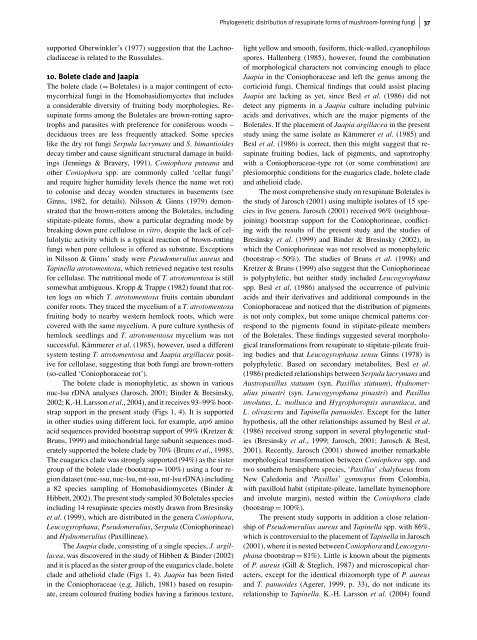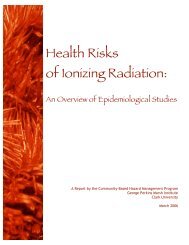The phylogenetic distribution of resupinate forms ... - Clark University
The phylogenetic distribution of resupinate forms ... - Clark University
The phylogenetic distribution of resupinate forms ... - Clark University
You also want an ePaper? Increase the reach of your titles
YUMPU automatically turns print PDFs into web optimized ePapers that Google loves.
supported Oberwinkler’s (1977) suggestion that the Lachnocladiaceae<br />
is related to the Russulales.<br />
10. Bolete clade and Jaapia<br />
<strong>The</strong> bolete clade (= Boletales) is a major contingent <strong>of</strong> ectomycorrhizal<br />
fungi in the Homobasidiomycetes that includes<br />
a considerable diversity <strong>of</strong> fruiting body morphologies. Resupinate<br />
<strong>forms</strong> among the Boletales are brown-rotting saprotrophs<br />
and parasites with preference for coniferous woods –<br />
deciduous trees are less frequently attacked. Some species<br />
like the dry rot fungi Serpula lacrymans and S. himantioides<br />
decay timber and cause significant structural damage in buildings<br />
(Jennings & Bravery, 1991). Coniophora puteana and<br />
other Coniophora spp. are commonly called ‘cellar fungi’<br />
and require higher humidity levels (hence the name wet rot)<br />
to colonise and decay wooden structures in basements (see<br />
Ginns, 1982, for details). Nilsson & Ginns (1979) demonstrated<br />
that the brown-rotters among the Boletales, including<br />
stipitate-pileate <strong>forms</strong>, show a particular degrading mode by<br />
breaking down pure cellulose in vitro, despite the lack <strong>of</strong> cellulolytic<br />
activity which is a typical reaction <strong>of</strong> brown-rotting<br />
fungi when pure cellulose is <strong>of</strong>fered as substrate. Exceptions<br />
in Nilsson & Ginns’ study were Pseudomerulius aureus and<br />
Tapinella atrotomentosa, which retrieved negative test results<br />
for cellulase. <strong>The</strong> nutritional mode <strong>of</strong> T. atrotomentosa is still<br />
somewhat ambiguous. Kropp & Trappe (1982) found that rotten<br />
logs on which T. atrotomentosa fruits contain abundant<br />
conifer roots. <strong>The</strong>y traced the mycelium <strong>of</strong> a T. atrotomentosa<br />
fruiting body to nearby western hemlock roots, which were<br />
covered with the same mycelium. A pure culture synthesis <strong>of</strong><br />
hemlock seedlings and T. atrotomentosa mycelium was not<br />
successful. Kämmerer et al. (1985), however, used a different<br />
system testing T. atrotomentosa and Jaapia argillacea positive<br />
for cellulase, suggesting that both fungi are brown-rotters<br />
(so-called ‘Coniophoraceae rot’).<br />
<strong>The</strong> bolete clade is monophyletic, as shown in various<br />
nuc-lsu rDNA analyses (Jarosch, 2001; Binder & Bresinsky,<br />
2002; K.-H. Larsson et al., 2004), and it receives 93–99% bootstrap<br />
support in the present study (Figs 1, 4). It is supported<br />
in other studies using different loci, for example, atp6 amino<br />
acid sequences provided bootstrap support <strong>of</strong> 99% (Kretzer &<br />
Bruns, 1999) and mitochondrial large subunit sequences moderately<br />
supported the bolete clade by 70% (Bruns et al., 1998).<br />
<strong>The</strong> euagarics clade was strongly supported (94%) as the sister<br />
group <strong>of</strong> the bolete clade (bootstrap = 100%) using a four region<br />
dataset (nuc-ssu, nuc-lsu, mt-ssu, mt-lsu rDNA) including<br />
a 82 species sampling <strong>of</strong> Homobasidiomycetes (Binder &<br />
Hibbett, 2002). <strong>The</strong> present study sampled 30 Boletales species<br />
including 14 <strong>resupinate</strong> species mostly drawn from Bresinsky<br />
et al. (1999), which are distributed in the genera Coniophora,<br />
Leucogyrophana, Pseudomerulius, Serpula (Coniophorineae)<br />
and Hydnomerulius (Paxillineae).<br />
<strong>The</strong> Jaapia clade, consisting <strong>of</strong> a single species, J. argillacea,<br />
was discovered in the study <strong>of</strong> Hibbett & Binder (2002)<br />
and it is placed as the sister group <strong>of</strong> the euagarics clade, bolete<br />
clade and athelioid clade (Figs 1, 4). Jaapia has been listed<br />
in the Coniophoraceae (e.g. Jülich, 1981) based on <strong>resupinate</strong>,<br />
cream coloured fruiting bodies having a farinous texture,<br />
Phylogenetic <strong>distribution</strong> <strong>of</strong> <strong>resupinate</strong> <strong>forms</strong> <strong>of</strong> mushroom-forming fungi 37<br />
light yellow and smooth, fusiform, thick-walled, cyanophilous<br />
spores. Hallenberg (1985), however, found the combination<br />
<strong>of</strong> morphological characters not convincing enough to place<br />
Jaapia in the Coniophoraceae and left the genus among the<br />
corticioid fungi. Chemical findings that could assist placing<br />
Jaapia are lacking as yet, since Besl et al. (1986) did not<br />
detect any pigments in a Jaapia culture including pulvinic<br />
acids and derivatives, which are the major pigments <strong>of</strong> the<br />
Boletales. If the placement <strong>of</strong> Jaapia argillacea in the present<br />
study using the same isolate as Kämmerer et al. (1985) and<br />
Besl et al. (1986) is correct, then this might suggest that <strong>resupinate</strong><br />
fruiting bodies, lack <strong>of</strong> pigments, and saprotrophy<br />
with a Coniophoraceae-type rot (or some combination) are<br />
plesiomorphic conditions for the euagarics clade, bolete clade<br />
and athelioid clade.<br />
<strong>The</strong> most comprehensive study on <strong>resupinate</strong> Boletales is<br />
the study <strong>of</strong> Jarosch (2001) using multiple isolates <strong>of</strong> 15 species<br />
in five genera. Jarosch (2001) received 96% (neighbourjoining)<br />
bootstrap support for the Coniophorineae, conflicting<br />
with the results <strong>of</strong> the present study and the studies <strong>of</strong><br />
Bresinsky et al. (1999) and Binder & Bresinsky (2002), in<br />
which the Coniophorineae was not resolved as monophyletic<br />
(bootstrap < 50%). <strong>The</strong> studies <strong>of</strong> Bruns et al. (1998) and<br />
Kretzer & Bruns (1999) also suggest that the Coniophorineae<br />
is polyphyletic, but neither study included Leucogyrophana<br />
spp. Besl et al. (1986) analysed the occurrence <strong>of</strong> pulvinic<br />
acids and their derivatives and additional compounds in the<br />
Coniophoraceae and noticed that the <strong>distribution</strong> <strong>of</strong> pigments<br />
is not only complex, but some unique chemical patterns correspond<br />
to the pigments found in stipitate-pileate members<br />
<strong>of</strong> the Boletales. <strong>The</strong>se findings suggested several morphological<br />
transformations from <strong>resupinate</strong> to stipitate-pileate fruiting<br />
bodies and that Leucogyrophana sensu Ginns (1978) is<br />
polyphyletic. Based on secondary metabolites, Besl et al.<br />
(1986) predicted relationships between Serpula lacrymans and<br />
Austropaxillus statuum (syn. Paxillus statuum), Hydnomerulius<br />
pinastri (syn. Leucogyrophana pinastri) andPaxillus<br />
involutus, L. mollusca and Hygrophoropsis aurantiaca, and<br />
L. olivascens and Tapinella panuoides. Except for the latter<br />
hypothesis, all the other relationships assumed by Besl et al.<br />
(1986) received strong support in several <strong>phylogenetic</strong> studies<br />
(Bresinsky et al., 1999; Jarosch, 2001; Jarosch & Besl,<br />
2001). Recently, Jarosch (2001) showed another remarkable<br />
morphological transformation between Coniophora spp. and<br />
two southern hemisphere species, ‘Paxillus’ chalybaeus from<br />
New Caledonia and ‘Paxillus’ gymnopus from Colombia,<br />
with paxilloid habit (stipitate-pileate, lamellate hymenophore<br />
and involute margin), nested within the Coniophora clade<br />
(bootstrap = 100%).<br />
<strong>The</strong> present study supports in addition a close relationship<br />
<strong>of</strong> Pseudomerulius aureus and Tapinella spp. with 86%,<br />
which is controversial to the placement <strong>of</strong> Tapinella in Jarosch<br />
(2001), where it is nested between Coniophora and Leucogyrophana<br />
(bootstrap = 81%). Little is known about the pigments<br />
<strong>of</strong> P. aureus (Gill & Steglich, 1987) and microscopical characters,<br />
except for the identical rhizomorph type <strong>of</strong> P. aureus<br />
and T. panuoides (Agerer, 1999, p. 33), do not indicate its<br />
relationship to Tapinella. K.-H. Larsson et al. (2004) found
















